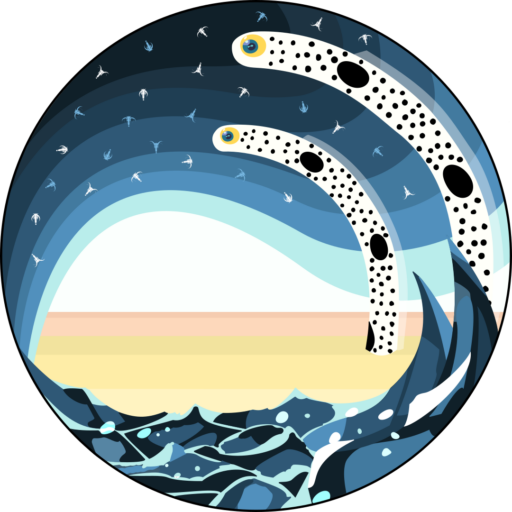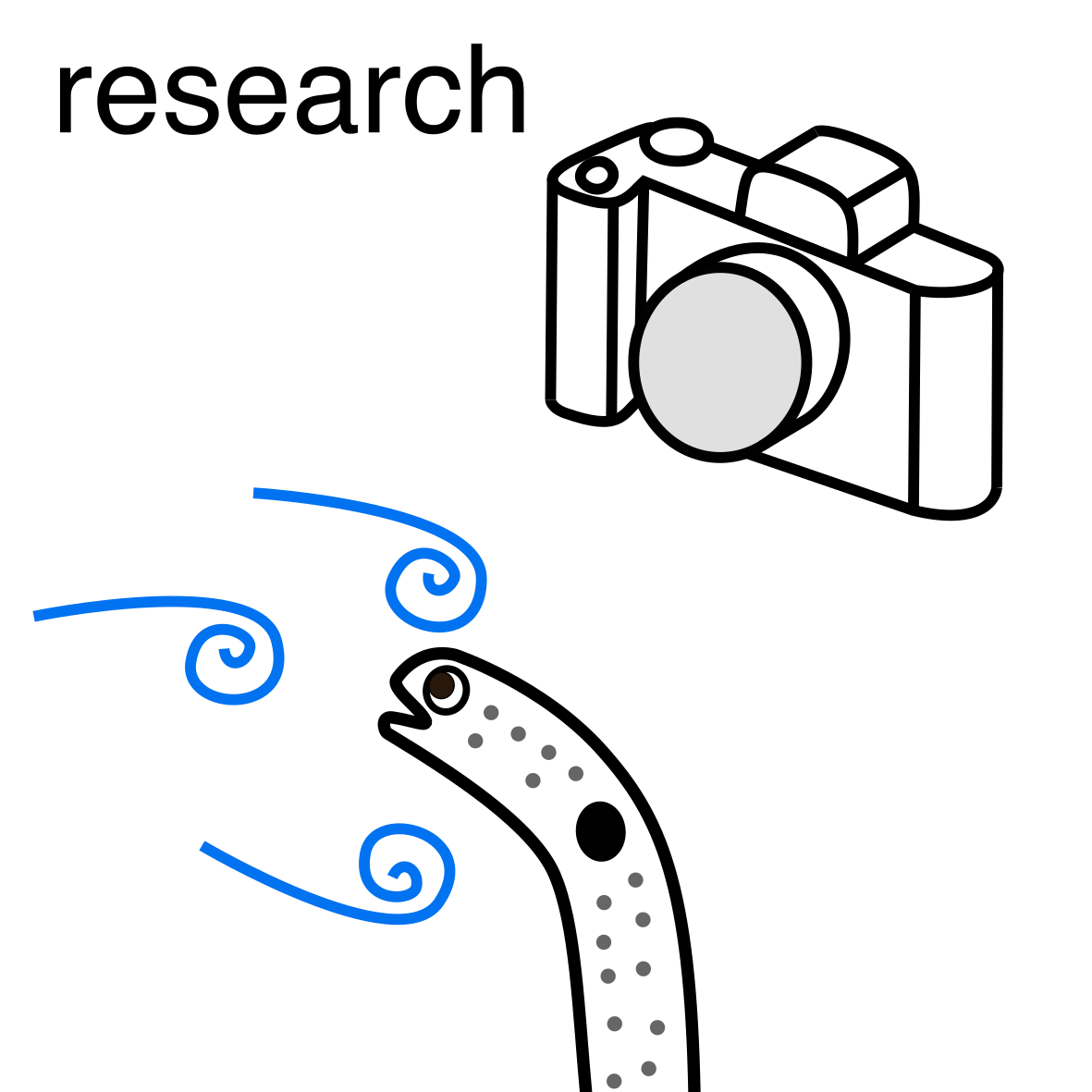
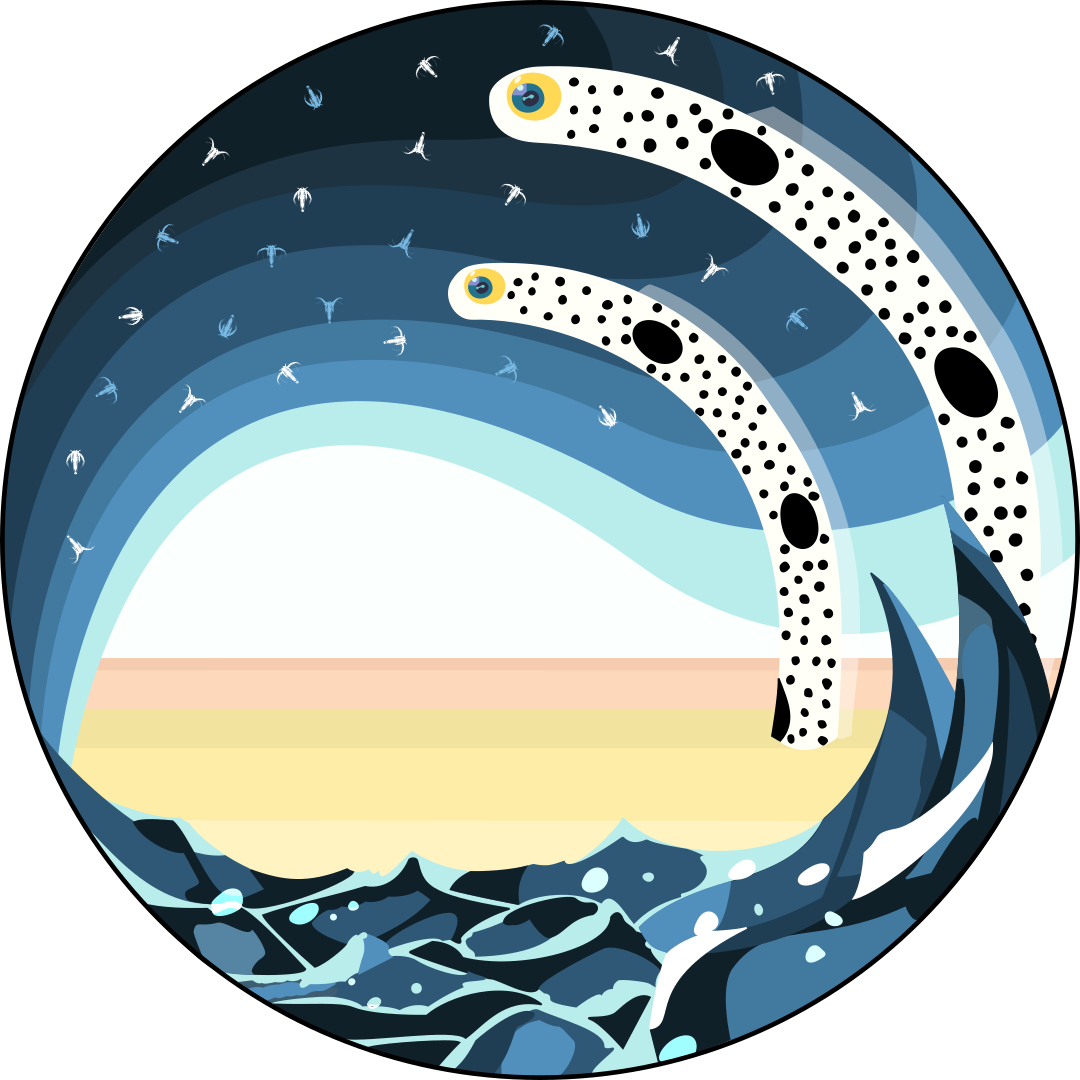
Feeding is how fish acquire energy for growth and reproduction1. Therefore, feeding behavior has been studied extensively. Fish feeding behavior depends on various factors such as flow, prey density, prey size, light, and predators2-11。
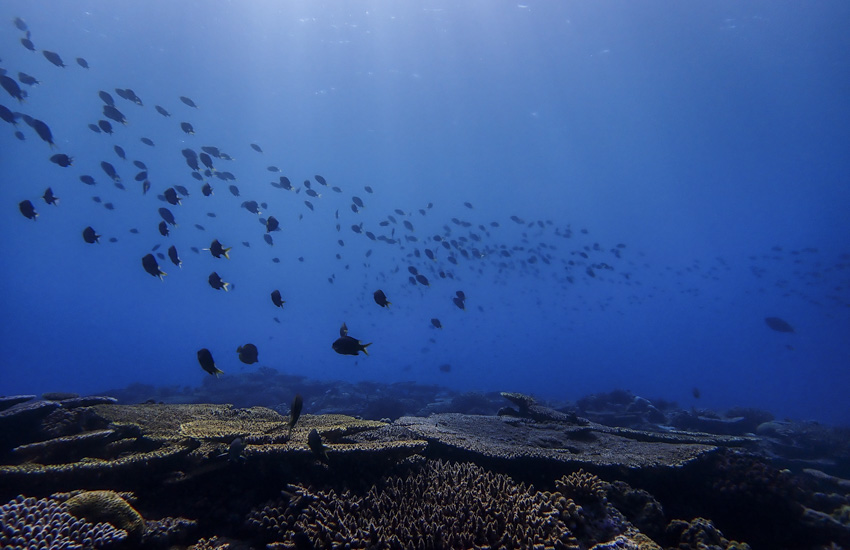
j2
Among these factors,
However, these studies have focused on swimming fish in coral reefs or rivers, taking advantage of coral shelter that decreases the flow speed experienced by fish by more than 60%13-15. Garden eels, however, live in fringe areas of coral reefs and don’t have shelter other than their burrow, which is why they are expected to have a unique feeding behavior depending on the flow.
Based on the above motivation, we are studying effects of flow speed on the garden eel’s feeding behavior. The relationships between flows and the feeding behavior of garden eels (Gorgasia sillneri) was studied for the first time by Khrizman et al (2018) in the Red Sea16. In their research, they found that the eels maintained their feeding rate even under strong flow speeds by decreasing the drag force through bending their posture.
However, because the research was done in the field, it was hard to exclude effects of other environmental factors. For this reason, additional research in the controlled lab condition is needed.
The tank in the picture below is called a “flume” in which you can freely control the flow speed. Using the flume, we are studying the detailed effects of flow speed on the feeding behavior of spotted garden eels (Heteroconger hassi) under controlled conditions.
This research is being conducted at the Okinawa Institute of Science Technology (OIST), where researchers from various background work together. This is an
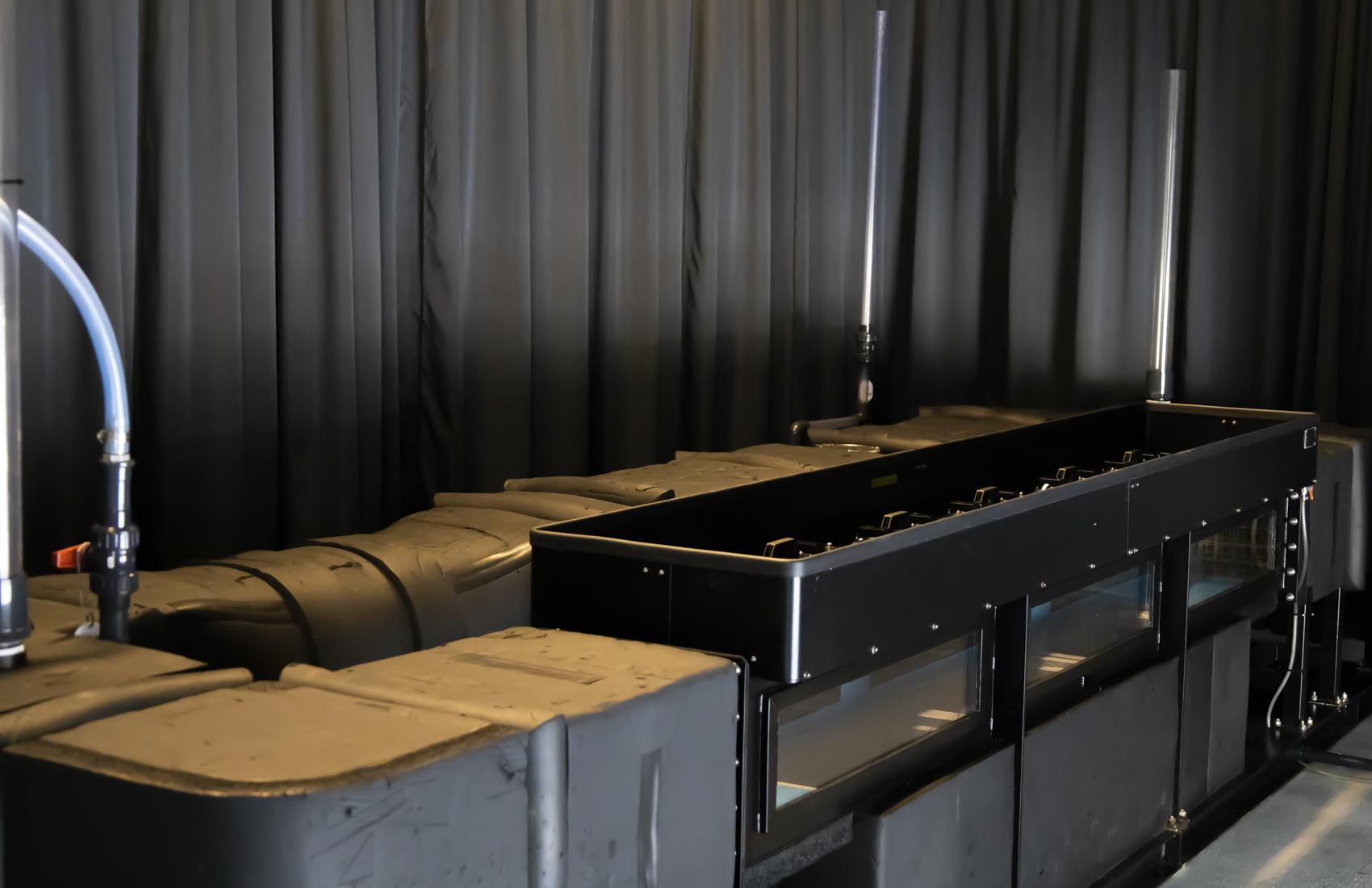
We are investigating the
3D reconstruction of feeding movement consist of tracking body parts and reconstructing 2D videos into 3D. In behavioral studies, animals are usually marked with something distinguishable such as beads and tracked with softwares. However, it is difficult to put markers on garden eels and even if it were possible, you would need to consider the effects of markers on their behavior. In our study, we need to track body features frame by frame which is an endless task if done manually; So we have automated the task using Python package, DeepLabCut, which tracks unlabeled points using deep learning (this package is free!)17,18。
Two of eyes enable us to convert visual information into three dimensions. In 3D reconstruction, multiple cameras are calibrated to track points while recording their relative position to one another. For this purpose, we are using dltdv package in Matlab19.
Even iPhones are suitable for this research!
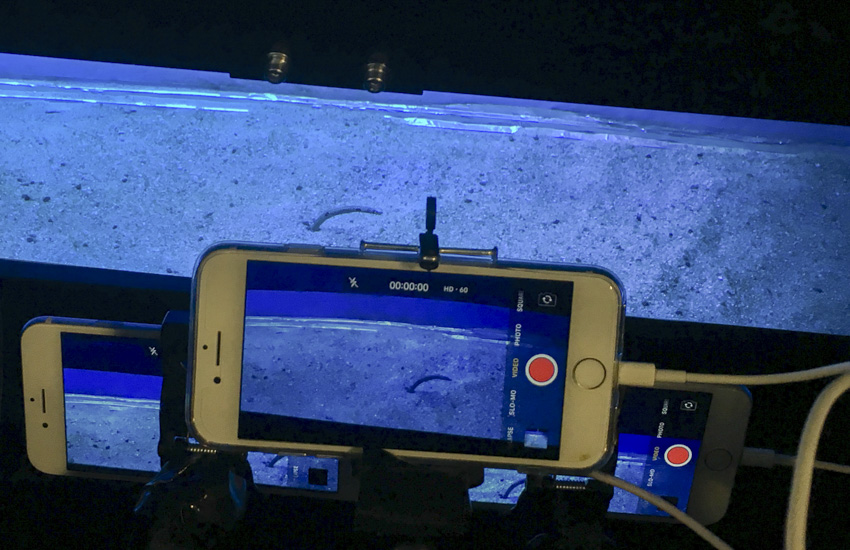
3D reconstructions of behavior enable us to investigate various parameters in detail, such as time, distance, speed, angle, and the trajectory of a garden eel capturing a prey item. With this detailed behavioral analysis, we are trying to reveal
The figure below shows the movement of a garden eel’s face under different flow speeds. Points indicate the location of the face in each frame. You can see that
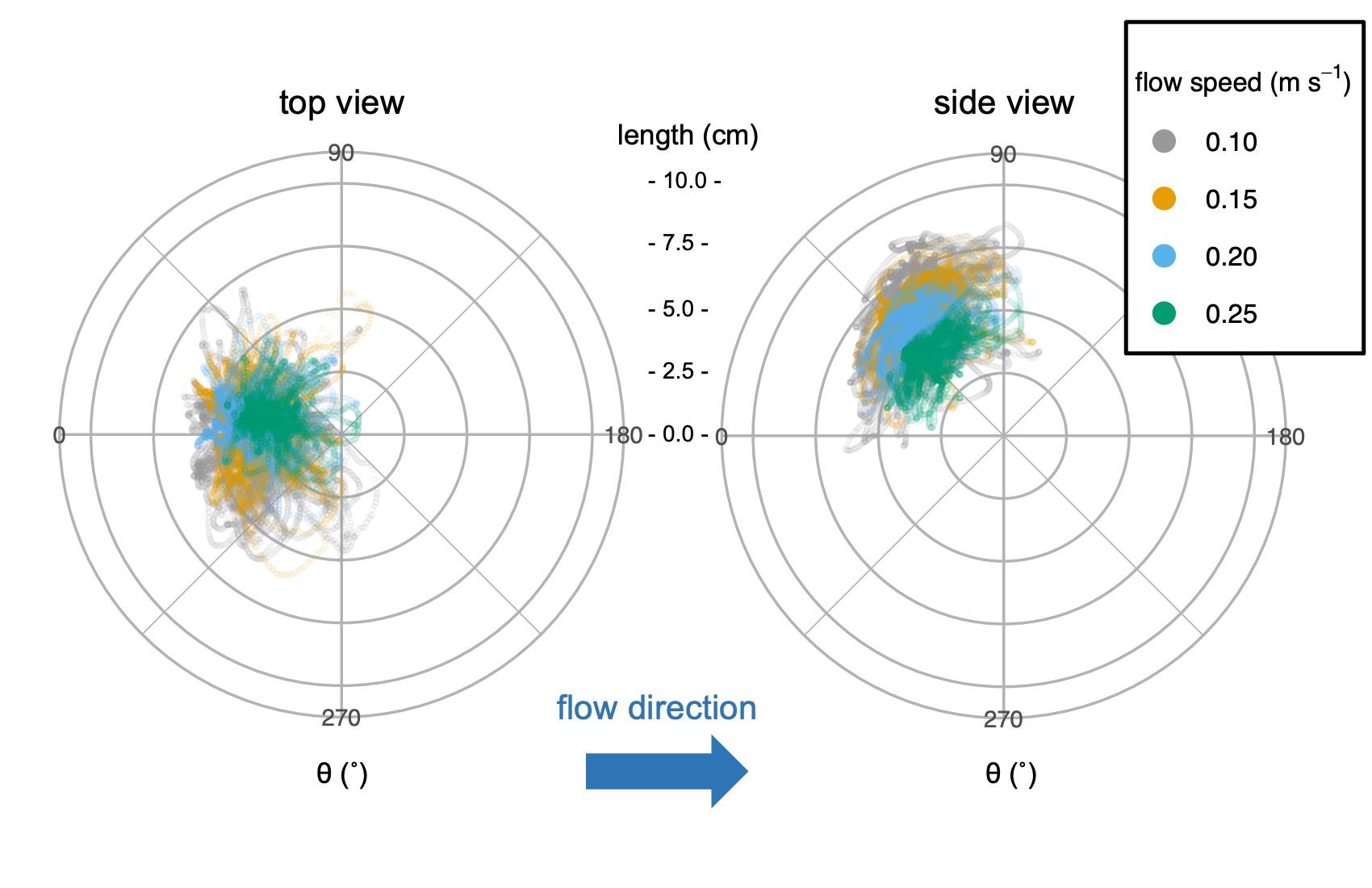
If you want to know more about the response of garden eels to flow speed, check out
Meet the garden eel – a shy creature who almost never leaves its burrow, even to feed. Now, the OIST Marine Biophysics Unit has conducted the first lab study on garden eels, revealing how their lifestyle pays off when feeding in strong currents @J_Exp_Biol https://t.co/RMxIyZoy9r pic.twitter.com/dxENPFuiEU
— OIST (@OISTedu) July 21, 2022
As we discussed, water flow is an important factor that affect behavior and metabolism of fish including garden eels. Especially, effects of flow speed have been well studied. Depending on flow speed, fish changes their swimming mode, feeding behavior, energy consumption, and sheltering behavior. 5,12,13,20,21
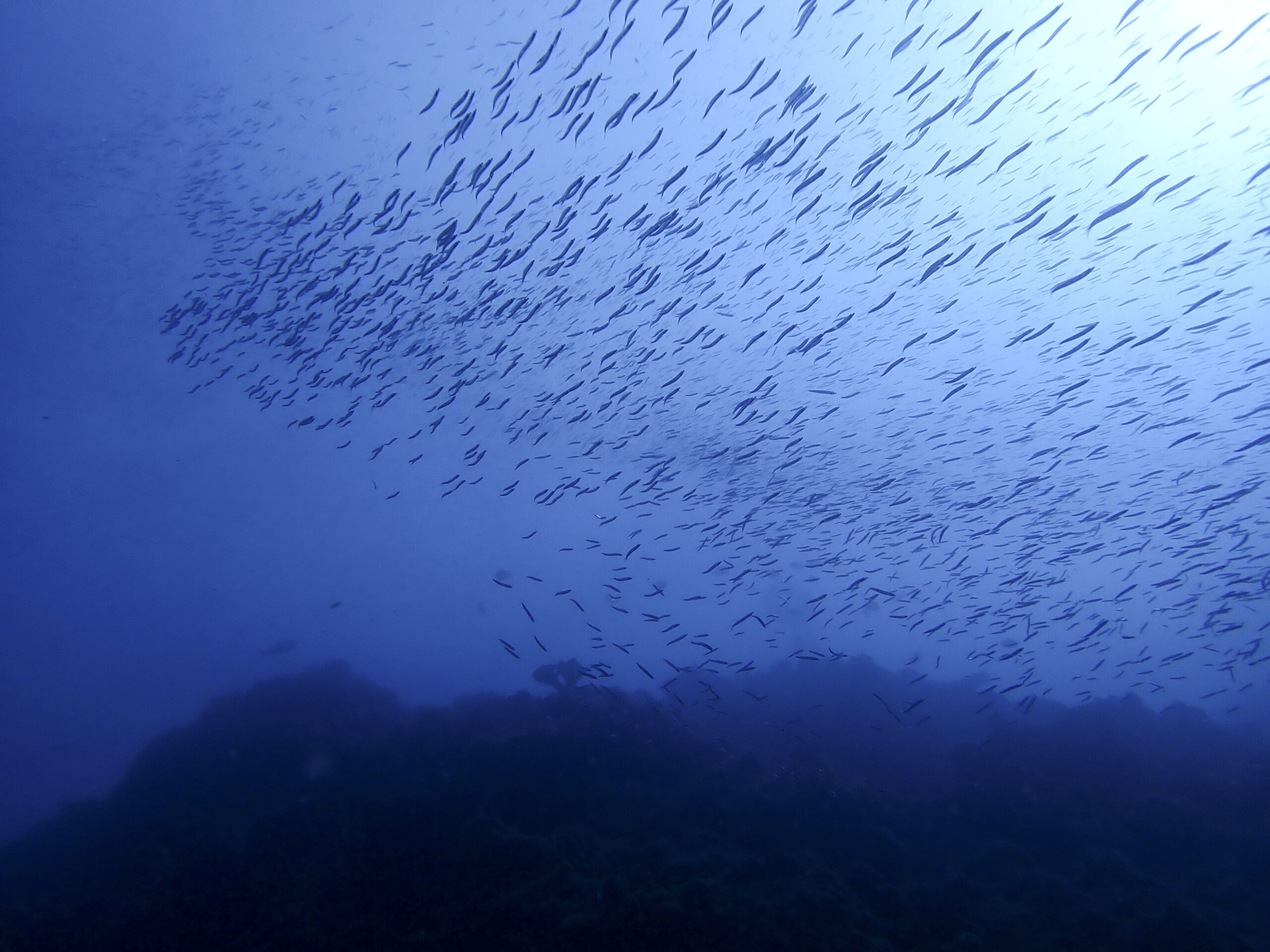
Although previous studies have mainly focused on effects of mean flow speed, recent research has begun to explore effects of complex flows that fish experience in natural habitats. One of the studies showed that fish can optimize body beat frequency to synchronize with the vortical flow patterns behind a cylinder (this study won Ig Nobel Prize in 2024!)22,23. Here is the footage of a dead fish “swimming” behind a cylinder due to motion induced by a specific flow pattern.
However, in such studies, the flow patterns are relatively predictable so that fish may be able to learn or predict these patterns to optimize their movements. Our study investigated effects of turbulence that characterized by random and stochastic motion of flows. We focused specifically on feeding behavior (as introduced here), and compared swimming blue-green chromis and stationary, anchored garden eels.
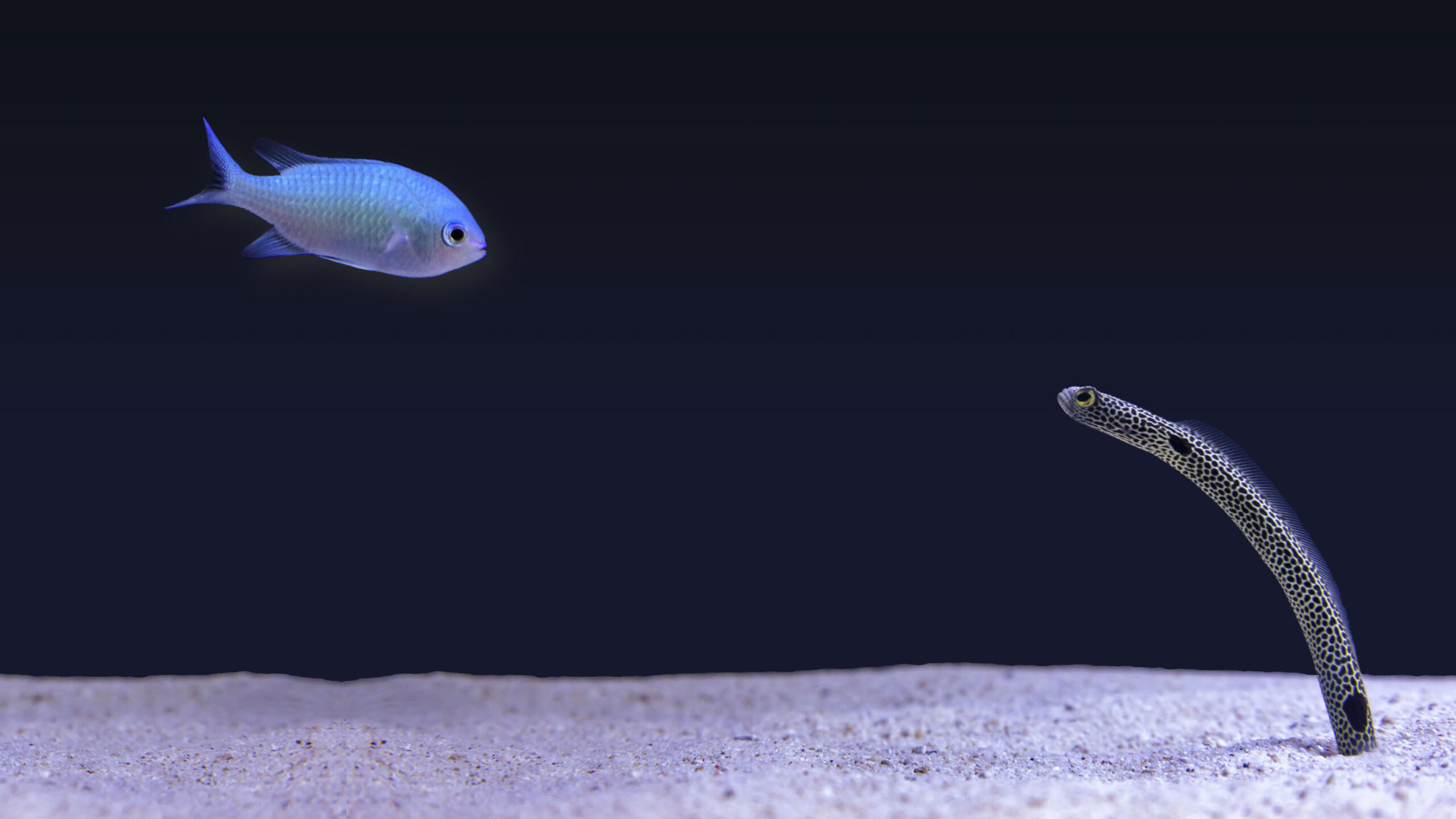
To examine effects of turbulence in a lab, we first measured turbulence that these fish experience in each natural habitat. Then, we produced grid-generated turbulence in a flume (flowing tank) and assessed it with particle image velocimetry (PIV). We eventually generated three turbulence level (dissipation rate) at each of the two mean flow speeds (0.05, 0.15 m/s).
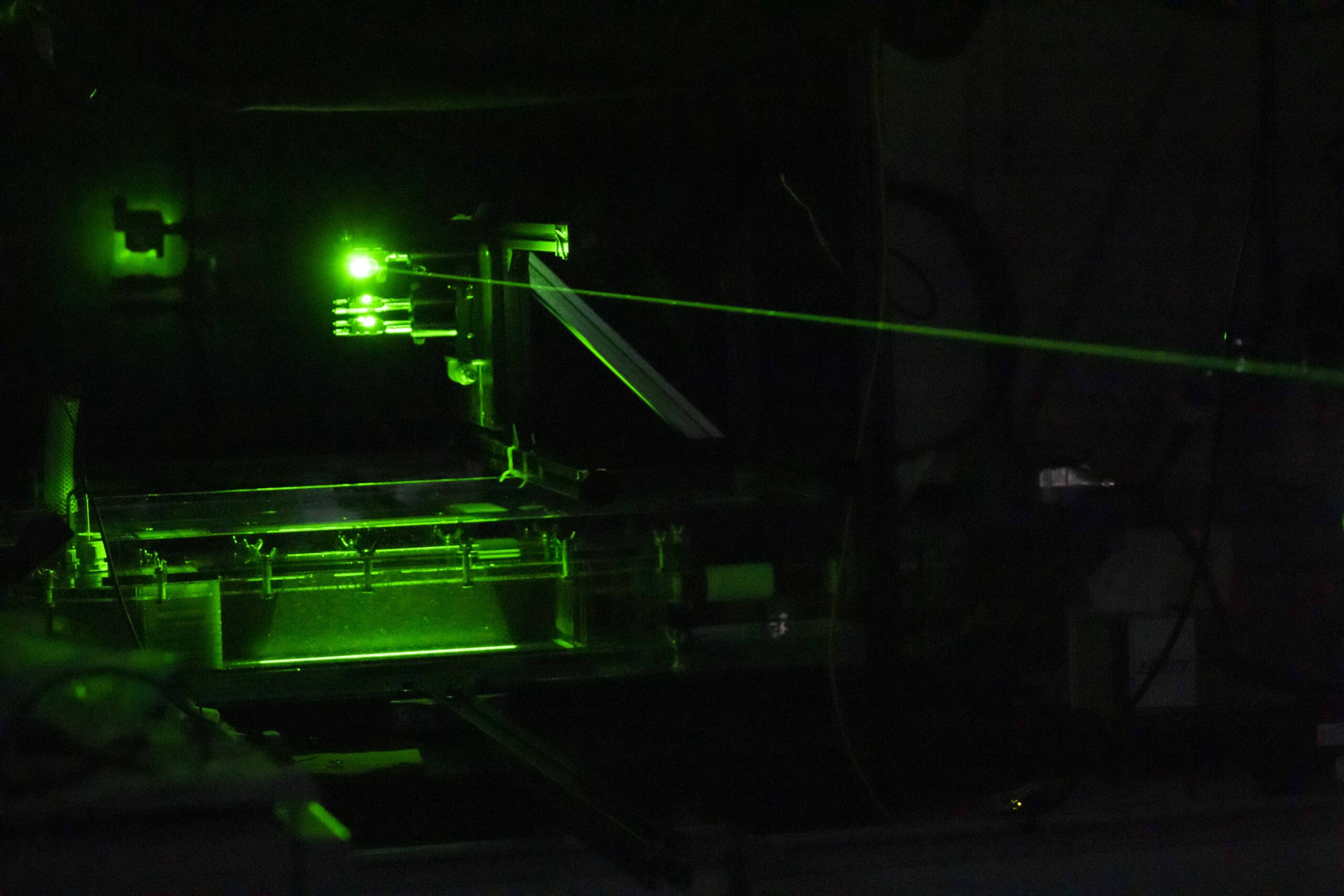
Finally, we examined fish behavior under these flow conditions, following our aforementioned study on garden eels. At strong turbulence, blue-green chromis reduced feeding rates at slow flow whereas garden eels showed the same response at fast flow. Based on the behavioral analysis, the reduction of feeding rates was caused by reduced swimming area in blue-green chromis and increased prey search time garden eels.
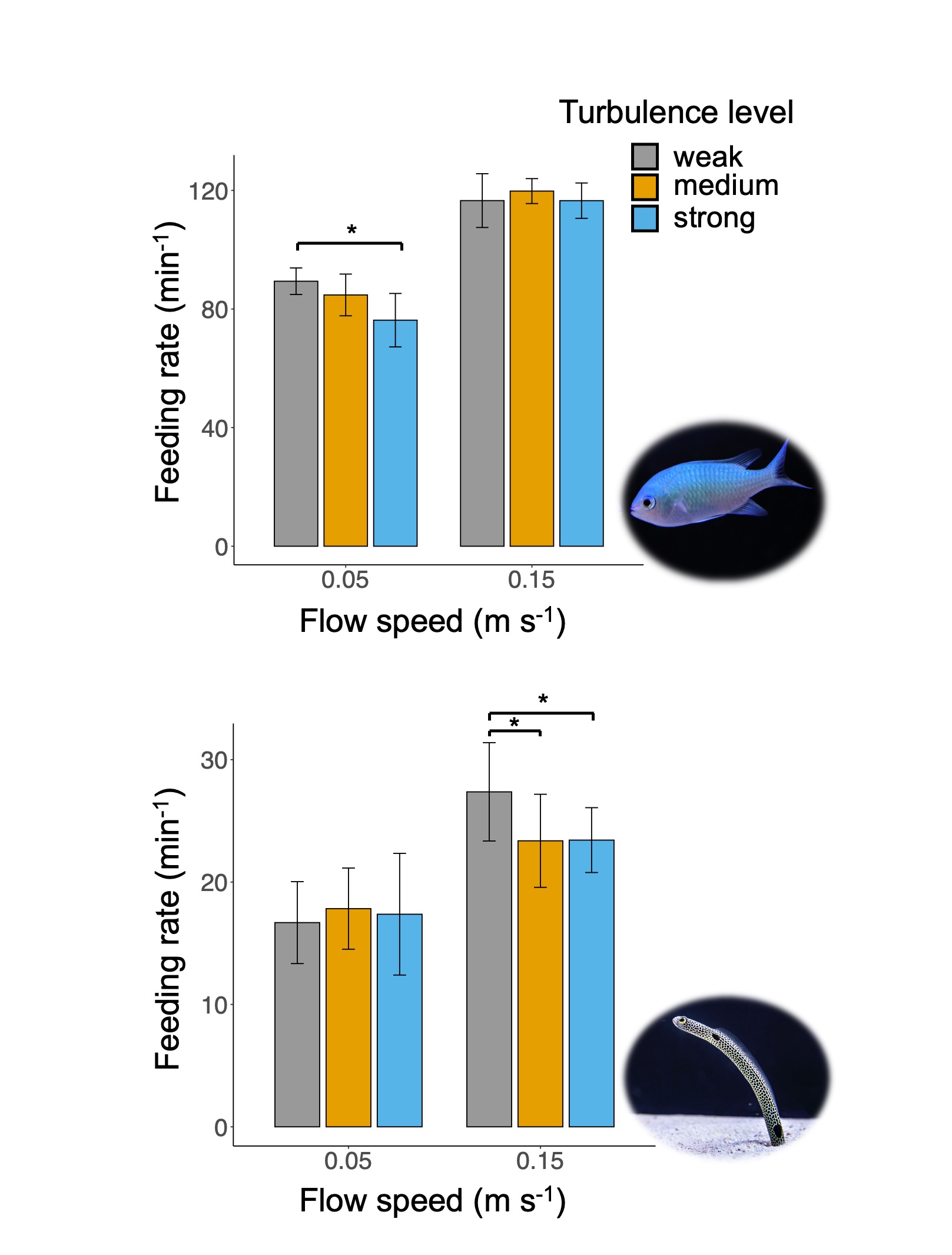
These results suggest that each fish species is adapted to flows at each habitat. Garden eels live in sandy bottom at depths more than 10 m, where flow is relatively slow and turbulence is weak. In contrast, blue-green chromis form a colony over corals, where flow is faster and turbulence is stronger. Garden eels maintained feeding behavior under any turbulence tested under slow flow but decreased their feeding rates at fast flow and strong turbulence. They may live in slow flow condition to avoid.
In garden eels, feeding behavior remained consistent across different levels of turbulence under slow flow. However, their feeding rates decreased under conditions of fast flow speed combined with strong turbulence. This suggests that garden eels inhabit slow flow environments to avoid conditions that reduce their feeding rate. In contrast, blue-green chromis showed stable feeding behavior across turbulence levels under fast flow, but showed reduced feeding rates under slow flow speeds combined with strong turbulence. Unlike garden eels, chromis can actively swim to locate microhabitats with weaker turbulence, thereby possibly mitigating the negative effects. These different responses to turbulence between species with different feeding strategies highlight their respective flow adaptations. Our findings emphasize the importance of incorporating turbulence into estimation of fish adaptive strategies and habitat use.
If you want to know more about effects of turbulence on garden eels and blue-green chromis, check out
~References~
1. Stoner, A. W. Effects of environmental variables on fish feeding ecology: Implications for the performance of baited fishing gear and stock assessment. J. Fish Biol. 65, 1445–1471 (2004).
2. Clarke, R. D., Finelli, C. M. & Buskey, E. J. Water flow controls distribution and feeding behavior of two co-occurring coral reef fishes: II. Laboratory experiments. Coral Reefs 28, 475–488 (2009).
3. Finelli, C. M., Clarke, R. D., Robinson, H. E. & Buskey, E. J. Water flow controls distribution and feeding behavior of two co-occurring coral reef fishes: I. Field measurements. Coral Reefs 28, 461–473 (2009).
4. Fulton, C. J., Bellwood, D. R. & Wainwright, P. C. Wave energy and swimming performance shape coral reef fish assemblages. Proc. R. Soc. B Biol. Sci. 272, 827–832 (2005).
5. Kiflawi, M. & Genin, A. Prey flux manipulation and the feeding rates of reef-dwelling planktivorous fish. Ecology 78, 1062–1077 (1997).
6. Noda, M., Kawabata, K., Gushima, K. & Kakuda, S. Importance of zooplankton patches in foraging ecology of the planktivorous reef fish Chromis chrysurus (Pomacentridae) at Kuchinoerabu Island, Japan. Mar. Ecol. Prog. Ser. 87, 251–263 (1992).
7. Hill, J. & Grossman, G. D. An Energetic Model of Microhabitat Use for Rainbow Trout and Rosyside Dace. Ecology 74, 685–698 (1993).
8. Manatunge, J. & Asaeda, T. Optimal foraging as the criteria of prey selection by two centrarchid fishes. Hydrobiologia 391, 223–240 (1998).
9. Howard, E. W. & Bori, L. O. Behavior of Marine Animals: Current Perspectives in Research. Plenum Press New York-London vol. 2 (Plenum Press, New York, 1972).
10. Rickel, S. & Genin, A. Twilight transitions in coral reef fish: The input of light-induced changes in foraging behaviour. Anim. Behav. 70, 133–144 (2005).
11. Morgan, M. J. The influence of hunger, shoal size and predator presence on foraging in bluntnose minnows. Anim. Behav. 36, 1317–1322 (1988).
12. Heatwole, S. J. & Fulton, C. J. Behavioural flexibility in reef fishes responding to a rapidly changing wave environment. Mar. Biol. 160, 677–689 (2013).
13. Johansen, J., Bellwood, D. & Fulton, C. Coral reef fishes exploit flow refuges in high-flow habitats. Mar. Ecol. Prog. Ser. 360, 219–226 (2008).
14. Johansen, J. L., Fulton, C. J. & Bellwood, D. R. Avoiding the flow: Refuges expand the swimming potential of coral reef fishes. Coral Reefs 26, 577–583 (2007).
15. Taguchi, M. & Liao, J. C. Rainbow trout consume less oxygen in turbulence: the energetics of swimming behaviors at different speeds. J. Exp. Biol. 214, 1428–1436 (2011).
16. Khrizman, A., Ribak, G., Churilov, D., Kolesnikov, I. & Genin, A. Life in the flow: unique adaptations for feeding on drifting zooplankton in garden eels. J. Exp. Biol. 221, (2018).
17. Mathis, A. et al. DeepLabCut: markerless pose estimation of user-defined body parts with deep learning. Nat. Neurosci. 21, 1281–1289 (2018).
18. Nath, T. et al. Using DeepLabCut for 3D markerless pose estimation across species and behaviors. Nat. Protoc. 14, 2152–2176 (2019).
19. Hedrick, T. L. Software techniques for two- and three-dimensional kinematic measurements of biological and biomimetic systems. Bioinspiration and Biomimetics 3, (2008).
20. O’Brien, W. J., Barfield, M. & Sigler, K. The functional response of drift-feeding Arctic grayling: the effects of prey density, water velocity, and location efficiency. Can. J. Fish. Aquat. Sci. 58, 1957–1963 (2001).
21. Piccolo, J. J., Hughes, N. F. & Bryant, M. D. Water velocity influences prey detection and capture by drift-feeding juvenile coho salmon ( Oncorhynchus kisutch) and steelhead ( Oncorhynchus mykiss irideus ). Can. J. Fish. Aquat. Sci. 65, 266–275 (2008).
22. Liao, J. C., Beal, D. N., Lauder, G. V. & Triantafyllou, M. S. Fish Exploiting Vortices Decrease Muscle Activity. Science 302, 1566–1569 (2003).
23. Liao, J. C. A review of fish swimming mechanics and behaviour in altered flows. Phil. Trans. R. Soc. B 362, 1973–1993 (2007).
